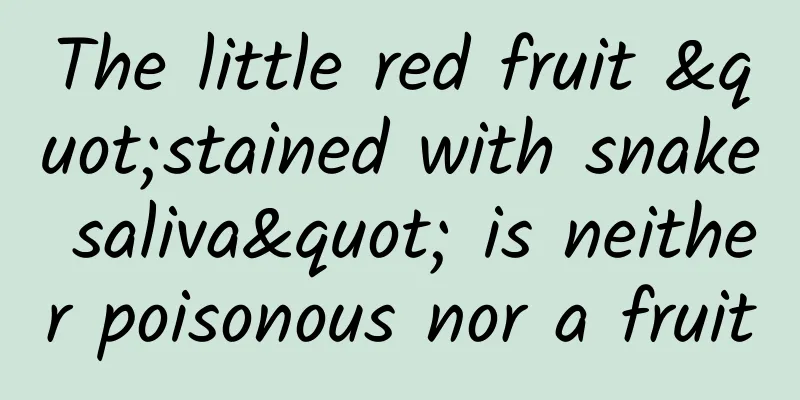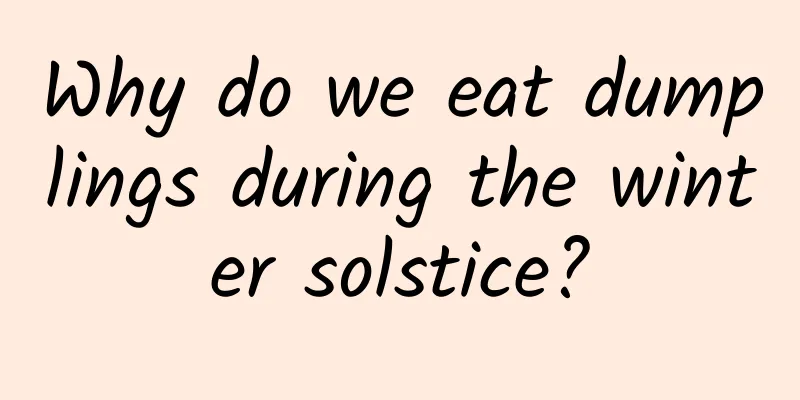The little red fruit "stained with snake saliva" is neither poisonous nor a fruit

|
As a botanist, the questions I answer most often every day are these three killer questions: Is this plant edible? Is it delicious? How do I eat it? Of course, the frequency of appearance of different plants varies greatly, because the appearance and attractiveness of different species can be said to be very different. Duchesnea indica is a star species that people often ask about, especially this season, when Duchesnea indica is very common in the wild. Snakeberry can be said to be the fruit that looks most like strawberry. The bright red "fruit" is very eye-catching in the grass. Against the backdrop of green, the feeling of freshness and deliciousness is ready to burst out, and it is natural to salivate. The "fruit" of snakeberry looks very tempting|4028mdk09 / Wikimedia Commons However, my parents wouldn’t let us eat it. The reason they didn’t allow us to eat it was that “snakeberries have been crawling on their surface and are covered with snake saliva, so they are poisonous and must not be eaten.” Although the old saying goes that if you don't listen to the advice of the elderly, you will suffer in the future, but in the wild, we still can't help but pick those ripe snakeberries and chew them slowly. After eating snakeberries, people don't have any strange reactions. Could it be that we eat too little and the toxicity has not taken effect? A strawberry face Duchesnea is a plant of the genus Duchesnea in the Rosaceae family. This genus has 5 to 6 species of plants, and only two species are distributed in China, namely Duchesnea and D. chrysantha. The two species are easy to distinguish, and the most typical difference is the color of the "fruit". The "fruit" of the former is bright red, while the "fruit" of the latter is pink. This "fruit" is actually not the fruit of the snakeberry, but its receptacle. The small hard particles like sesame seeds on the "receptacle" are the real fruit. The receptacle of the red snakeberry is pink. | Sphl / Wikimedia Commons Duchesnea is a distant relative of strawberry and is often called wild strawberry. As sister genera that love each other, Duchesnea and Fragaria share common characteristics - well-developed fleshy receptacles and many small fruits on the receptacles. When the fruits are ripe, the red fleshy receptacles become more attractive. They use the nutritious fleshy receptacles to attract animals to eat, thereby spreading seeds with the help of the animals' digestive systems. Like snakeberry and strawberry, there are many plants with "false fruits". For example, the seemingly large "fruit" of pineapple is actually many small fruits growing on the inflorescence axis. The cashews we eat are the seeds of the cashew tree. When they were alive, there was a super large fruit holder growing on them. This fruit holder is sweet and sour and can also be eaten as fruit. These structures are all created to lure animals and spread seeds. In nature, the way flowering plants spread their seeds has undergone a long evolutionary process, and any resources that can be utilized will be placed in the right place. Cashew nut, the big red one on top is the fruit holder, the real fruit is below, wrapped in a poisonous shell, and its seed is the cashew nut|Pixabay So, what is the difference between snakeberry and strawberry? The most typical difference is in the flowers. The flowers of snakeberry are yellow, while the flowers of strawberry are white. However, when snakeberry and strawberry bear fruit, we can rarely see the flowers. Another difference is the sepals, which are the small green pieces under the red receptacle. The inner circle is called sepals, and the outer circle is called epicalyx. Both strawberries and snakeberries have 5 sepals and 5 epicalyx. The epicalyx of snakeberries is larger than the sepals, while the epicalyx of strawberries is slightly smaller than the sepals. The receptacle of snakeberry, the outer circle of poker-card "clover" shapes are epicalyx segments, and the inner circle of pointed ones are sepals|Shyamal L. / Wikimedia Commons The strawberry (Fragaria × ananassa) we often eat is the offspring of the hybridization of two wild strawberry plants, the Virginia strawberry (F. virginiana) and the Chilean strawberry (F. chiloensis). Its fruit is yellow-white, while the fruit of the snakeberry is red, which is easy to distinguish. Some wild strawberry plants have red fruits like the snakeberry, but there are some differences between the snakeberry and them. Generally speaking, the small fruits on the receptacle of the snakeberry protrude from the surface of the receptacle, while the fruits of the strawberry plant are slightly sunken or deeply sunken in the receptacle. This is enough for us to distinguish between the snakeberry and the strawberry plant in most cases. Dried snakeberry receptacle with tiny fruits on it|Roger Culos / Wikimedia Commons Another common type of small fruit found in the wild are members of the genus Rubus, which produces many delicious fruits, some of which, such as the red raspberry (R. idaeus), are cultivated as fruit. Wild red raspberry fruit | mako / Wikimedia Commons Rubus is also a member of the Rosaceae family. Many species have bright red fruits that are somewhat similar to those of the genus Duchesnea. But it is not difficult to distinguish them. The fruits of the genus Rubus are aggregate fruits composed of many small drupes. In "From the Baicao Garden to Sanwei Bookstore", Lu Xun described the raspberry as "a small ball made of small coral beads". It is a plant of the genus Rubus, and it may be the fruit of R. hirsutus. Snakes are vegetarians? No kidding. Okay, after recognizing snakeberry and strawberry, the key question comes, can snakeberry be eaten? To humans, the "fruit" of snakeberry has no obvious aroma or sweetness. Therefore, even as a wild fruit for tasting, snakeberry is not qualified enough and can only be used as a prop for children to play house. However, when you encounter this attractive fruit in the wild, you still have the urge to try it. After all, free fruit is very attractive to people. Things that don't cost money feel different when they are in your mouth. The flowers of snakeberry are yellow|Jrosenberry1 / Wikimedia Commons But is the curse attached to the snakeberry real or fake? Whether the snakeberry is poisonous or not has always been controversial. Some people say that you can eat it casually without worrying about it; others think that you should be careful when eating snakeberry, as eating too much may cause diarrhea. Jishou University in Hunan Province conducted a study on the toxicity of snakeberry. They gavage-fed mice a large amount of dried snakeberry powder (equivalent to a 50-kg person eating one kilogram of snakeberry a day), and no abnormal reactions occurred, so snakeberry can be said to be non-toxic. As for the legend of snakes drooling, a little analysis will reveal that it is full of loopholes: first, snake venom must enter the body through a broken wound to be toxic to humans; second, venomous snakes are not venomous all over their bodies, and their saliva is not toxic. The venom is stored in the venom glands and is only released when defending or attacking. In addition, snakes will not smear their saliva on fruits casually, because they are not vegetarians! The flowers, receptacles and fruits of forest strawberry. Its receptacles and fruits are very similar to those of snakeberry, but taste better than those of snakeberry|xulescu_g / Flickr But why do some people still say that snakeberry is poisonous? It may be related to the living environment of snakeberry. Snakeberry likes to grow on the edge of semi-shaded and semi-wet fields. Not only farmyard manure may stick to it, but livestock feces may also fall on the fruits of the snakeberry at any time. There are likely to be pathogenic microorganisms in these rice fields. Therefore, eating snakeberry may cause stomach upset, but the cause of stomach upset is not the snake's saliva - so, do you still want to eat the free little red fruit now? Not tasty, but you can find a job Although the fruit of the snakeberry is not tasty enough and has no potential to be domesticated into fruit, the snakeberry with its strong vitality may become an excellent lawn and green space plant. Especially for those bare sandy lands that are in urgent need of covering, planting snakeberry is a good choice. Isn’t it tempting? | cogdogblog / Wikimedia Commons The snakeberry is not picky about the growing environment. Various sandy soils, loess, humus soil, etc. can all be good growth substrates for the snakeberry. However, it is not resistant to sunlight, so it usually needs a semi-shaded environment to thrive. This just provides a special choice for gardeners as a greening plant. In some places where there is insufficient light and the lawn is not suitable for growth, the snakeberry can be allowed to settle down, which is also a good use of it. Snakeberry is not delicious, but cherry is definitely the delicacy of this season. However, have you ever tasted "Chinese cherry"? 👇 Author: Shi Jun This article comes from the Species Calendar, welcome to forward If you need to reprint, please contact [email protected] |
<<: Go to Jiangxi and see Poyang Lake!
Recommend
Today in Science and Technology History | 1997·9·25 Chinese scholars solved the mystery of "Shangri-La"
In 1933, British writer James Hilton described in...
How to promote App with low cost and very good results on AppStrore hot search - Sina Weibo
Starting from December last year, you can often s...
It calls eight times in one breath. What kind of mysterious bird is this?
A bird's eye view of science Quanzhou Associa...
Great news in the bird world: the population of red-crowned cranes has exceeded 10,000!
The reporter recently learned from the "Ecol...
How to increase product user growth? Share the 8-step plan!
The author uses a real case to explain how to bui...
Attracting 5.6 million viewers in one hour? Watch Baidu Mobile Assistant play "different live broadcast"
Almost overnight, beautiful internet celebrities b...
The victory of "beating" Cook and the mediocre people are complacent about
[[149617]] Five years have passed. Jobs' tomb...
I'm tired of waiting and found out that iOS 9.2 beta4 is the official version
After 3 weeks of waiting, we finally welcomed the...
Drones are now popular, how can we develop them into large-scale commercial use?
The road to commercialization of drones: Is it re...
What are these black spots on the edge of bus glass used for?
Image source: Tuchong Creative What are these bla...
No experience in short video advertising? The experienced driver will help you overtake on the curve!
This article mainly introduces the preparations b...
Guangzhou self-service car wash mini program development function, how much does it cost to develop a self-service car wash mini program?
Nowadays, "cars" as a means of transpor...
Import open source libraries into projects built on Android Studio
[[126313]] Since Google released the official ver...
Simple web page editing software, web page editing software Notepad++ 7.7.1 version!
v7.7.1 version update says 1. Fixed the drag and ...
May 30 pays tribute to science and technology workers. Do you know their brilliant achievements?
On May 30th, National Science and Technology Work...









